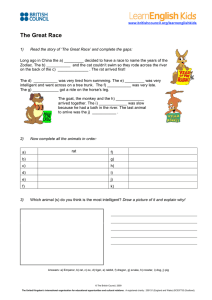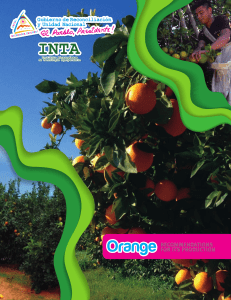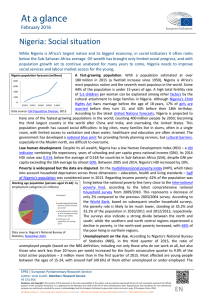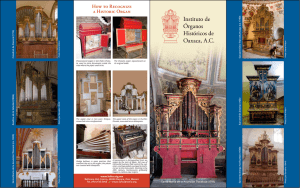Effect of Season on the Reproductive Organs
Anuncio
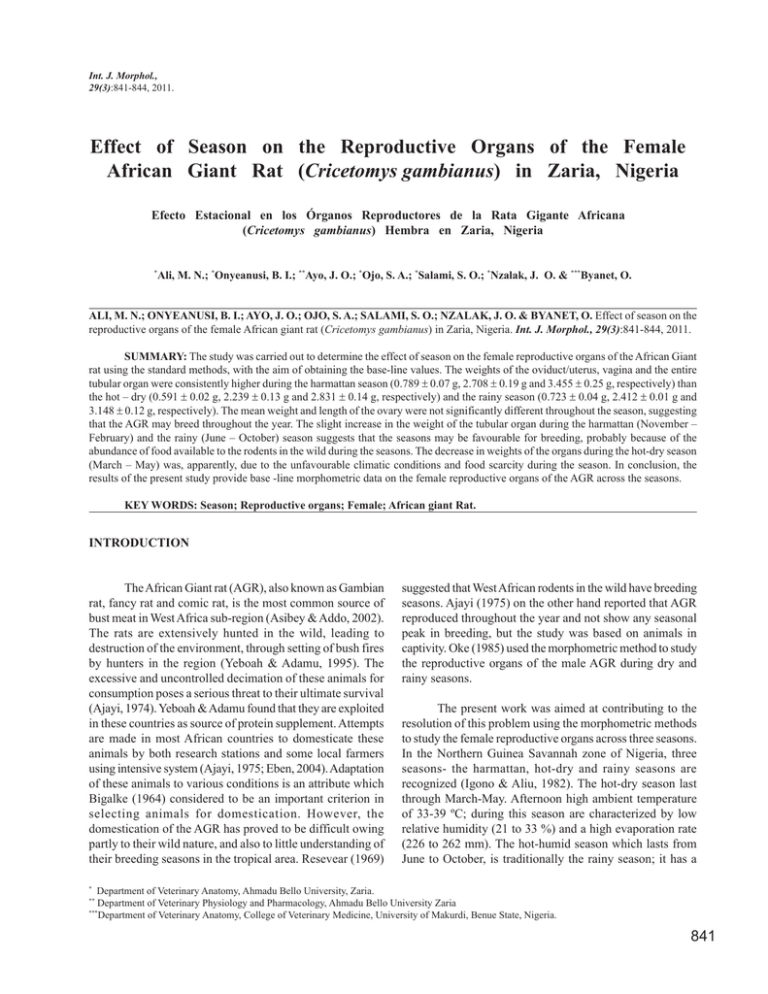
Int. J. Morphol., 29(3):841-844, 2011. Effect of Season on the Reproductive Organs of the Female African Giant Rat (Cricetomys gambianus) in Zaria, Nigeria Efecto Estacional en los Órganos Reproductores de la Rata Gigante Africana (Cricetomys gambianus) Hembra en Zaria, Nigeria * Ali, M. N.; *Onyeanusi, B. I.; **Ayo, J. O.; *Ojo, S. A.; *Salami, S. O.; *Nzalak, J. O. & ***Byanet, O. ALI, M. N.; ONYEANUSI, B. I.; AYO, J. O.; OJO, S. A.; SALAMI, S. O.; NZALAK, J. O. & BYANET, O. Effect of season on the reproductive organs of the female African giant rat (Cricetomys gambianus) in Zaria, Nigeria. Int. J. Morphol., 29(3):841-844, 2011. SUMMARY: The study was carried out to determine the effect of season on the female reproductive organs of the African Giant rat using the standard methods, with the aim of obtaining the base-line values. The weights of the oviduct/uterus, vagina and the entire tubular organ were consistently higher during the harmattan season (0.789 ± 0.07 g, 2.708 ± 0.19 g and 3.455 ± 0.25 g, respectively) than the hot – dry (0.591 ± 0.02 g, 2.239 ± 0.13 g and 2.831 ± 0.14 g, respectively) and the rainy season (0.723 ± 0.04 g, 2.412 ± 0.01 g and 3.148 ± 0.12 g, respectively). The mean weight and length of the ovary were not significantly different throughout the season, suggesting that the AGR may breed throughout the year. The slight increase in the weight of the tubular organ during the harmattan (November – February) and the rainy (June – October) season suggests that the seasons may be favourable for breeding, probably because of the abundance of food available to the rodents in the wild during the seasons. The decrease in weights of the organs during the hot-dry season (March – May) was, apparently, due to the unfavourable climatic conditions and food scarcity during the season. In conclusion, the results of the present study provide base -line morphometric data on the female reproductive organs of the AGR across the seasons. KEY WORDS: Season; Reproductive organs; Female; African giant Rat. INTRODUCTION The African Giant rat (AGR), also known as Gambian rat, fancy rat and comic rat, is the most common source of bust meat in West Africa sub-region (Asibey & Addo, 2002). The rats are extensively hunted in the wild, leading to destruction of the environment, through setting of bush fires by hunters in the region (Yeboah & Adamu, 1995). The excessive and uncontrolled decimation of these animals for consumption poses a serious threat to their ultimate survival (Ajayi, 1974). Yeboah & Adamu found that they are exploited in these countries as source of protein supplement. Attempts are made in most African countries to domesticate these animals by both research stations and some local farmers using intensive system (Ajayi, 1975; Eben, 2004). Adaptation of these animals to various conditions is an attribute which Bigalke (1964) considered to be an important criterion in selecting animals for domestication. However, the domestication of the AGR has proved to be difficult owing partly to their wild nature, and also to little understanding of their breeding seasons in the tropical area. Resevear (1969) suggested that West African rodents in the wild have breeding seasons. Ajayi (1975) on the other hand reported that AGR reproduced throughout the year and not show any seasonal peak in breeding, but the study was based on animals in captivity. Oke (1985) used the morphometric method to study the reproductive organs of the male AGR during dry and rainy seasons. The present work was aimed at contributing to the resolution of this problem using the morphometric methods to study the female reproductive organs across three seasons. In the Northern Guinea Savannah zone of Nigeria, three seasons- the harmattan, hot-dry and rainy seasons are recognized (Igono & Aliu, 1982). The hot-dry season last through March-May. Afternoon high ambient temperature of 33-39 ºC; during this season are characterized by low relative humidity (21 to 33 %) and a high evaporation rate (226 to 262 mm). The hot-humid season which lasts from June to October, is traditionally the rainy season; it has a * Department of Veterinary Anatomy, Ahmadu Bello University, Zaria. Department of Veterinary Physiology and Pharmacology, Ahmadu Bello University Zaria *** Department of Veterinary Anatomy, College of Veterinary Medicine, University of Makurdi, Benue State, Nigeria. ** 841 ALI, M. N.; ONYEANUSI, B. I.; AYO, J. O.; OJO, S. A.; SALAMI, S. O.; NZALAK, J. O. & BYANET, O. Effect of season on the reproductive organs of the female African giant rat (Cricetomys gambianus) in Zaria, Nigeria. Int. J. Morphol., 29(3):841-844, 2011. high temperature maxima of 29 to 33 ºC, high relative humidity (57 to 69 %) and a low evaporation rate (144 to 164 mm). The harmattan season, lasting November to February, is dust-laden, rain- free and has a high temperature maxima (29 to 35ºC). MATERIAL AND METHOD Animals. A total of 100 adult non-gravid, female AGRs were used for this study. The animals were caught alive from surrounding villages around Zaria, Kaduna State, Nigeria. They were housed in metal cages in the Experimental Animal Unit of the Department of Veterinary Anatomy, Faculty of Veterinary Medicine, Ahmadu Bello University Zaria, and allowed to acclimatize for 2 to 3 days before exsanguinations. Organs collection. The animals were anaesthetized lightly using chloroform, and weighed using a weighing balance (Ohaus Scale Crop) with a sensitivity of 0.1 g. They were then sacrificed by severing the jugular vein. The animals were then placed on a dorsal recumbency and a mid-line incision was made, starting from the xiphoid cartilage to the pubic symphysis. The peritoneum was reflected and the intestine displaced to gain access to the reproductive organs. The organs were examined in situ and exteriorized. The length, weight and width of the reproductive organs were measured using ruler and thread, weighing balance and vernier caliper, respectively. The organs were weighed using a Mettler balance P1210 (Mettle Instrument AG, Switzerland) with a sensitivity of 0.01g. The ovarian length was measured from pole to pole and the diameter was calculated from the circumference. Statistical Analysis. The data generated were expressed as mean ± standard error of the mean (Mean ± SEM) and subjected to statistical analysis using one-way analysis of variance (ANOVA) and further subjected to a post- hoc test (Duncan multiple range test). Values of P< 0.05 were considered significant. RESULTS AND DISCUSSION The weights of the oviduct/uterus, vagina/vestibule and the entire weight of the tubular organ were higher during the harmattan season (0.786 ± 0.07 g, 2.708 ± 0.19 g and 3.455 ± 0.25 g, respectively) than the hot-dry season (0.591 ± 0.02 g, 2.239 ± 0.13 g, and 2.831 ± 0.14 g, respectively) and the rainy season (0.723 ± 0.04 g, 2.412 ± 0.01 g, and 842 3.148 ± 0.12 g, respectively). As shown in Fig. 2, there was no significant difference (P > 0.05) in the length of the female reproductive organs across all the seasons. The weights and length of the ovary during harmattan, hot-dry and rainy were (0.092 ± 0.01 g, 0.094 ± 0.01 g and 0.085 ± 0.02 g) and (0.743 ± 0.01 cm, 0.756 ± 0.01 cm and 0.749 ± 0.01 cm), respectively. The weight and length of the ovary were not significantly different throughout the season, suggesting that the AGR may breed throughout the season. The ovarian parameters obtained in this study showed that the AGR may breed throughout the year. The mean weight and length of the ovary of the AGR were not significantly different throughout the season. The results of the current study agreed with the findings of Oke, who reported that the male AGR did not appear to be a seasonal breeder because the reproductive organs were active throughout the year. He also did not observe any significant differences in most of the values obtained between the seasons. The works of Molokwu & Umunna (1980) and Hambolu et al. (1985) on the ovarian morphometry of the Yankasa sheep showed that there was no significant difference in the ovarian parameters obtained across the seasons. This also corresponds to the ovarian parameters observed in this study. Oke reported that the mean values of the reproductive organs of the male AGR were consistently higher in the dry season (November-February) than the rainy season (MarchOctober). The observations were also similar to the findings obtained in this study. The weight of the tubular organ was consistently higher during the harmatttan (NovemberFebruary), which corresponded to the dry season reported by Oke. Hence, it appeared that during the harmattan, there was an increased activity in the reproductive organs of the AGR, suggesting that the season may be the most favourable one for breeding in the AGR. The decrease in weight of the tubular organs of AGR during the hot-dry season (March-May) may be due to the unfavourable climatic conditions observed during this period. This finding agreed with that of Ayo et al. (1996), who reported that heat stress during this period has adverse effects on the reproductive activities of animals. The slight increase in parameters of tubular organs during the rainy season (JuneOctober) also corresponded to the abundance of food during this season. The dry season in Nigeria is a period in which crops grown during the rainy season are harvested, and when plants bear fruits and shed their leaves in preparation for the rainy (growing) season. During the preceeding (rainy) season, there are abundant edible materials available to the rodents ALI, M. N.; ONYEANUSI, B. I.; AYO, J. O.; OJO, S. A.; SALAMI, S. O.; NZALAK, J. O. & BYANET, O. Effect of season on the reproductive organs of the female African giant rat (Cricetomys gambianus) in Zaria, Nigeria. Int. J. Morphol., 29(3):841-844, 2011. Fig. 1. Seasonal variation in weights (g) of female reproductive organs in the African Giant rat (Mean ± SEM). Fig. 2. Length values (cm) of the reproductive organs in the African Giant rat. (Mean ± SEM). in the wild. This factor may be important in the slight increase in the activity of the reproductive organs observed during the harmattan season. Rosevear suggested that West African rodents in the wild have breeding seasons. Ajayi (1975) on the other hand reported that AGR reproduced throughout the year and did not show any seasonal peak in breeding. His work was, however based on animals in captivity. In conclusion, the results of this present work may contributed to the AGR reproduction by elucidating the variation in the morphometry of the reproductive organs of the female AGR during the three seasons in Zaria, located in the Northern Guinea Savannah Zone of Nigeria. 843 ALI, M. N.; ONYEANUSI, B. I.; AYO, J. O.; OJO, S. A.; SALAMI, S. O.; NZALAK, J. O. & BYANET, O. Effect of season on the reproductive organs of the female African giant rat (Cricetomys gambianus) in Zaria, Nigeria. Int. J. Morphol., 29(3):841-844, 2011. ALI, M. N.; ONYEANUSI, B. I.; AYO, J. O.; OJO, S. A.; SALAMI, S. O.; NZALAK, J. O. & BYANET, O. Efecto estacional en los órganos reproductores de la rata gigante Africana (Cricetomys gambianus) hembra en Zaria, Nigeria. Int. J. Morphol., 29(3):841-844, 2011. RESUMEN: Este estudio se llevó a cabo para determinar el efecto de las estaciones en los órganos reproductores femeninos de la rata gigante Africana mediante los métodos estándar, con el objetivo de obtener los valores basales. El peso del oviducto/útero, vagina y el órgano tubular completo fueron consistentemente más altos durante harmattan (la estación seca en Nigeria) (0,789±0,07 g, 2,708±0,19g y 3,455±0,25, respectivamente) que la estación seca-calurosa (0,591 ± 0,02 g, 2.239 ±0,13g y 2.831±0,14, respectivamente) y la estación de lluvias (0,723±0,04 g, 2,412±0,01 y 3,148±0,12 g, respectivamente). La media de peso y longitud del ovario no fueron significativamente diferentes a lo largo de las estaciones, lo que sugiere que la rata gigante africana puede reproducirse durante todo el año. El ligero aumento en el peso del órgano tubular en las estaciones de harmattan (noviembre - febrero) y de lluvias (junio-octubre), sugiere que las estaciones pueden ser favorables para la reproducción, probablemente debido a la abundancia de alimentos disponibles para los roedores silvestres durante estas temporadas. La disminución en el peso de los órganos durante la estación cálida y seca (marzo - mayo) fue, al parecer, debido a las desfavorables condiciones climáticas y la escasez de alimentos durante la estación. En conclusión, los resultados de este estudio proporcionan una línea base de datos morfométricos para los órganos reproductores de la rata gigante africana hembra a través de las estaciones. PALABRAS CLAVE: Estación; Órganos reproductivos; Hembra; Rata gigante africana. REFERENCES Ajayi, S. S. The Biology and Domestication of the African Giant Rat (Cricetomys gambianus -Waterhouse). Ph.D Thesis. Ibadan, Nigeria, University of Ibadan, 1974. Molokwu, E. C. I. & Umunna, N. N. Reproductive performance of Yankasa sheep of Nigeria. Theriogenology, 14:239-49, 1980. Ajayi, S. S. Domestication of the African Giant Rat. Ibadan, University of Ibadan, Department of Forest Resource Management, Nigeria, 1975. pp.1-44 Oke, B. O. Effect of season on the reproductive organs of the male African giant rat (Cricetomys gambianus Waterhouse) in Ibadan, Nigeria. Afr. J. Ecol., 23(1):6770, 1985. Asibey, E. O. A. & Addo, P. G. The grasscutter, a promising animal meat production in Ghana, African Perspectives, Practices and policies Supporting Scandinavian Seminar College, Denmark, in association with Weaver Press, Harare Zambabwe, 2002. Avalaible in: http:// www.cdr.dk/sscafrica/asddad-gh.htm Rosevear, D. R. The Rodents of West Africa. British Museum of National History. 1st Ed. Publication No. 667. London, Spothswode, 1969. Yeboa, S. & Adamu, E. K. The cane rat. Biologist, 42(2):867, 1995. Ayo, J. O.; Oladele, S. B. & Fayomi, A. Effect of heat stress on livestock production. Niger. Vet. J., 1:58-68, 1996. Bigalke, R. C. Can Africa produce new domestic animals? New Scient., 374:141-6, 1964. Eben, A. B. Grasscutter: Importance, Habitat , Characteristics, Feed and feeding, Breeding and Disease. Kumasi, Ghana, CBUD, 2004. pp.1- 6. Correspondence to: Ali, M. N. Department of Veterinary Anatomy Ahmadu Bello University Zaria NIGERIA Email: [email protected] Hambolu, J. O. & Ojo, S. A. Ovarian activity of Red Sokoto goats using abattoir specimens. Theriogenology, 23(2):273-82, 1985. Igono, M. O. & Aliu, Y. O. Enviromental profile and milk Production of Friesian Zebu crosses in Nigeria Guinea Savannah. Int. J. Biometeorol., 26:115-20, 1982. 844 Received: 20-07-2010 Accepted: 12-04-2011
